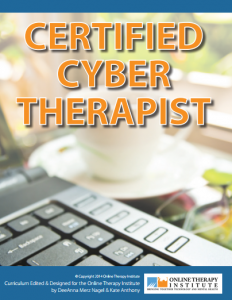(This GUEST BLOG `by Carole Francis-Smith is the first in a series of articles written for TILT (Therapeutic Innovations in Light of Technology). Unforeseen interruptions in the usual  production process of TILT mean that we shall be blogging articles until further notice. If you would like to submit a TILT Guest Blog, please email kate@onlinetherapyinstitute.com to discuss further. Writer Guidelines can be seen here.)
production process of TILT mean that we shall be blogging articles until further notice. If you would like to submit a TILT Guest Blog, please email kate@onlinetherapyinstitute.com to discuss further. Writer Guidelines can be seen here.)
Firstly, I would like to say thank you Kate for allowing me to air my research findings and also to declare myself a first-time blogger, although a long-time follower.
Secondly I would like to share my thoughts on some of the interesting aspects that came out of the doctoral research I conducted as part of the counselling psychology training I undertook at the University of the West of England (see Email therapy and the therapeutic relationship: A grounded theory analysis of therapists’ experiences.)
The research gave me a fascinating insight into what happens to the process of email therapy when it is altered by the lack of sensory cues, by anonymity and things like time delays through the computer ‘looking glass’ screen.
Using a constructionist grounded theory methodology (Charmaz, 2008), a combination of anonymous online surveys and interviews (face-to-face/webcam/email) were utilised to ask therapists – all of whom were accredited by a professional body and who also conducted online therapy – about their experiences of the therapeutic relationship when counselling by email.
The research showed that operating by email resulted in a high level of anxiety for participants, perhaps through the high level of perceived threat ranging from fears about client safety to exposure to the World Wide Web.
One of the key areas of concern was being able to provide therapeutic containment for clients: ‘the ability to hold the client’s emotional distress in the therapy process’ (Gravell, 2010). This ability would seem somewhat eroded by losing control of the process, often in relation to the time distortion effect on the speed a client might read a response or the online disinhibition effect which might cause clients to self-disclose at an accelerated and possibly unsafe rate. Whilst client containment has been proposed as a necessarily asymmetric process being the responsibility of the therapist (Aron, 1996), in email counselling particularly it makes sense that the responsibility is highly weighted toward the therapist – possibly through the lack of non-verbal cues that might indicate how a client is receiving their therapy.
The unease of some of the interviewees, a proportion of whom were new to online work, about creating a safe space for therapeutic connection could be supported by research into the role of mirror neurons in neuropsychology (Schore, 2013). Some authors have suggested that the ‘gaze’ of the therapist is crucial in the process and that the non-conscious transference-countertransference relationship, thought to be critical to clinical effectiveness according to those theories that utilise such terminology, is reliant on this safe place. Although Schore is referring to physical gaze it could be argued that emotional proximity (Holmes, 2001) is not reliant on this and there is certainly research with clients that indicates it is possible to engender an online therapeutic alliance that is demonstrably equivalent to face to face work (Hanley & Reynolds, 2009; Cook & Doyle, 2002).
With these discussions in mind, it is interesting that participants referred to using intuition in engendering the therapeutic relationship but could only be reassured a relationship was developing if a client responded acknowledging empathy. Whilst it was clear many participants felt developing a therapeutic relationship was possible a psychological definition of intuition (or gut feelings) is described as decision making based in both conscious reasoning (including non-verbal communications) as well as past experience and knowledge – and in this respect would be quite restricted. This supports the notion that therapists might be mostly relying on their own mental constructs to build rapport (Anthony, 2000) postulating that we are mostly working with our reflection in the looking glass – important then that those embarking on online working already have a degree of therapeutic experience. Making sense that a ‘feeling the fear and doing it anyway’ type of robustness seemed necessary to negotiate the ‘highway’.
In this study the resultant anxiety seemed to have pushed participants into a range of defensive behaviours, but the underlying anxieties were somewhat alleviated by having had adequate training.
Despite the BACP guidelines strongly advocating training there is still mostly no input on core counselling or psychology trainings, and when I came to undertake the research I realised what a big hole I had in my own knowledge of this area. I further trained as an online therapist but kept a hybrid research position by not counselling online until completion. This was also done out of respect to my participants who I understand are sometimes asked to participate in online research and fill in the gaps for researchers. The perceived lack of importance put on specific training might in some way account for a feeling that online therapy is undervalued, when in fact it requires a high level of commitment, engagement and skill.
This leads nicely into some wider thinking on operating by email. This research indicated that a unique process is in play when working with the asynchronous method of email, and whilst these research findings suggested a looking glass process for therapists it also suggested a parallel process might be happening for clients (albeit perhaps in a more unconscious way). Participants in this study described ‘training’ their clients to read and respond safely and it struck me how communicating by email has come up behind us, at least for those not already thoroughly immersed in specifically therapeutic use of the medium. Despite being part of our every day lives none of us had training in everyday email exchanges– which is perhaps why individuals and businesses can quickly get into trouble!
If you would like to contact Carole, author of this blog post, you can go to www.carolefrancissmith.co.uk
Interested in training or in learning how to transfer your face to face skills to the online environment? Click here to view details of our Certified Cyber Therapist course and other options for training.
References
Anthony, K. (2000). The nature of the therapeutic relationship within online counselling. Online Therapy Institute. Available online at https://www.onlinetherapyinstitute.com/2011/02/24/the-nature-of-the-therapeutic-relationship-within-online-counselling/. Accessed November 19th, 2015.
Aron, L. (1996). A Meeting of Minds: Mutuality in Psychoanalysis. HIillsdale, NJ: The Atlantic Press.
Charmaz, K. (2008). Constructionism and the grounded theory. In: J.A. Holstein and J.F. Gubrium (Eds.) Handbook of Constructionist Research. (pp. 397-412). New York: The Guildford Press.
Cook, J.E., and Doyle, C. (2002). Working Alliance in online therapy as compared to face-to-face therapy: Preliminary results. CyberPsychology & Behavior, 5(2), pp. 52-105.
Francis-Smith, C. & Halewood, A. (2014). Email Counselling and the Therapeutic Relationship: A Grounded Theory Study. University of the West of England Repository. Available online at http://eprints.uwe.ac.uk/24554/7/Thesis%20amended%20for%20repository.pdf. Accessed November 23rd, 2015.
Gravell, L. (2010). The Counselling Psychologist as Therapeutic ‘Container’. Counselling Psychology Review, 25(2) pp. 28-33.
Hanley, T. and Reynolds, D.J. (2009). Counselling Psychology and the internet: A review of the quantitative research into online outcomes and alliances within text-based therapy. Counselling Psychology Review, 24(2), pp. 4-11.
Holmes, J. (2001). The Search for the Secure Base. East Sussex: Routledge.
Schore, A.N. (2013). Affect Regulation and the Repair of the Self. New York: Norton.


